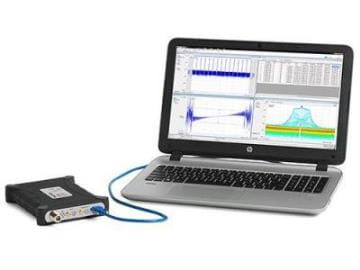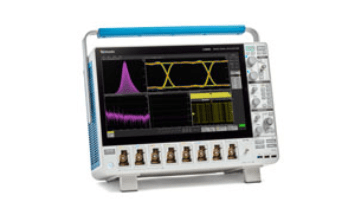联系我们
与泰克代表实时聊天。 工作时间:上午 9:00 - 下午 5:00(太平洋标准时间)。
致电我们
工作时间:上午9:00-下午5:00(太平洋标准时间)
下载
下载手册、产品技术资料、软件等:
反馈
了解射频测试:无线系统成功的关键
射频 (RF) 测试是测量和分析用于传输各种应用中的信号的电磁波的过程,应用场景从无线通信和广播到雷达和卫星系统等。RF 测试涉及评估这些信号的性能、强度和质量,以确保它们符合特定的标准和要求。这对于 RF 组件和系统的开发、验证和维护至关重要,因为它有助于识别可能影响无线通信和传感系统的功能和可靠性的任何问题。此外,RF 测试还能确保电磁兼容性 (EMC),包括发射和抗干扰能力,这对于防止干扰以及确保电子设备在环境中和谐运行至关重要。
了解如何进行:
什么是射频测试?
RF 测试对于确保无线通信系统和电子设备的最佳性能和可靠性至关重要。通过开展全面的 RF 测试,工程师可以检测并解决与信号完整性、干扰和整体系统效率相关的问题。这不仅能提高无线电元件和系统的质量和功能,还能确保符合行业标准和监管要求。有效的 RF 测试可最大限度地降低代价高昂的故障风险,最大限度地提高运行效率,并让人们对无线技术在实际条件下的预期性能充满信心。最后,RF 测试对于开发、认证和维护依赖无线电频率的设备(从日常消费电子产品到专用工业设备)至关重要,可帮助公司在当今高度互联的世界中获得竞争优势。
频率(频谱)与时域分析
了解频率(频谱)和时域分析之间的异同点对于有效开展射频 (RF) 测试至关重要。每个域都提供了独特的见解,可用于优化无线通信,并确保无线通信在规定的频率分配范围内正常进行。
频域(频谱)分析
定义:频率(频谱)分析是评估电磁信号的频谱以识别和测量其特性(例如幅度、频率和相位)的过程。利用频谱分析仪,工程师可以检测和诊断信号干扰、杂散发射和谐波等问题。频谱分析有助于精准识别指定带宽内的不同信号源,确保系统高效运行,不会无端受到干扰。它是开发、测试和维护无线通信系统、广播设备、雷达和其他 RF 应用的基本工具。
用例:频谱分析对多个行业都至关重要,包括蜂窝网络和无线通信、广播、雷达和国防、航空航天、医疗设备、研发、合规性测试和工业应用,因为电磁频谱受到 ITU、FCC 和欧盟等各组织的严格监管。它可确保设备符合这些法规,帮助有效管理频谱,并识别干扰源。
挑战与解决方案:频率分析面临几大挑战,包括管理日益拥挤的频段、识别并缓解信号干扰,以及确保在复杂环境中进行精确测量。工程师还必须要跟上无线技术的快速发展,这就要求不断更新测试方法和设备。此外,在始终遵循严格监管标准的同时,又要优化信号性能,这又增加了一重复杂性。要应对这些挑战,需要有先进的仪器和软件来确保 RF 系统可靠、高效地运行。
时域分析
定义:时域分析用于检查 RF 信号随时间的变化情况,重点关注的是相位、幅度和频率的变化。它能让我们深入了解信号的动态特性。
用例:RF 信号的时域分析具有几个关键优势,包括能够实时捕获和分析瞬态事件和非重复信号行为。该方法提供了对信号幅度、相位和时序特性的详细洞察,从而能够对 RF 系统进行精准的故障排除和优化。时域分析对于识别快速上升沿、脉冲信号、锁相环、频率稳定问题以及同步问题特别有效。
挑战与解决方案:时域方面的主要挑战是准确描述快速变化的信号,这对于先进通信系统和雷达技术至关重要。高带宽时域分析可以准确捕捉时间上的微小变化,并将这些变化与信号在频域中的行为联系起来,从而帮助克服这一问题。
射频测试(RF 测试)的重要工具和系统
射频测试对于确保无线通信和传感设备的性能和效率至关重要。 在这里,我们重点介绍射频测试中使用的基本工具,包括实时频谱分析仪、示波器和任意波形发生器,它们在测试过程中都发挥着独特的作用。
用于射频测试的硬件和系统
实时频谱分析仪 (RSA)
主要功能:
- 高速性能:RSA 专为快速、无缝捕获和分析高带宽 RF 信号而设计。
- 实时功能:与传统频谱分析仪不同,RSA 可实时处理其瞬时带宽内的信号,帮助捕捉到其他仪器可能忽略的瞬态事件。它们能够对复杂通信和雷达信号进行全面分析。
应用:在测试动态无线信号和复杂干扰场景等对速度和精度要求极高的环境中,RSA 是不可或缺的。
典型的使用场所:
- 实验室环境:RSA 通常在研发实验室中使用,用于开发融合无线技术的新组件和系统,在此类环境中,实时分析对于检测快速移动的异常和杂散信号至关重要。
- 制造工厂 (Fab):在制造测试中,RSA 可确保产品符合所需的 RF 和发射规范,并可在产品交付给最终用户之前帮助校准产品的 RF 功率。
- 现场测试:工程师使用便携式 RSA 进行现场诊断、故障排除和现场系统验证,特别是在雷达、电信和广播领域。
示波器
主要功能:
- 多种带宽选项:瞬时带宽从几兆赫到几千兆赫不等。
- 多通道型号:提供 2 通道、4 通道和最多 8 通道配置,增强了同时监控多个信号的能力。
应用:示波器对于详细分析电子信号的时域特性至关重要,尤其适合在研发环境中进行调试和信号完整性检查。
典型的使用场所:
- 实验室环境:对于研究、开发和验证电子信号的时序行为至关重要。
- 制造工厂 (Fab):用于确保电子设计和系统在生产过程中满足严格的时序标准。
- 现场测试:采用便携式模型,以在通信基础设施站点等实际操作环境中诊断问题,排除故障。
任意波形发生器 (AWG)
主要功能:
- 灵活性:AWG 具有无与伦比的功能,可根据特定测试条件生成任何波形,既可以是单次出现的波形,也可以是重复信号。
应用:AWG 在模拟复杂波形和测试不同信号条件下的设备响应方面尤为重要,有助于开发稳健高效的无线设备。
典型的使用场所:
- 实验室环境:广泛用于设计和测试阶段,以模拟和分析不同的信号场景。
- 制造工厂 (Fab):对验证最终产品的功能和在现实条件下进行压力测试至关重要。
- 现场测试:对于在现场生成所需的特定信号,以测试实际环境中的系统响应非常有用。
RF 测试软件概述
软件在 RF 测试中发挥着至关重要的作用,可通过先进的信号处理、分析和仿真能力来增强硬件的功能。
主要功能:
- 信号分析:软件工具提供广泛的分析结果,帮助工程师了解频谱利用率、信号调制质量、系统稳定性和性能。
- 仿真功能:RF 测试软件可以模拟复杂的无线环境和信号交互,让工程师能够预测设备在实际场景中的表现。
- 自动化测试:许多 RF 测试软件包都包含自动化功能,可简化测试过程,减少人为错误,同时提高可重复性和效率。
- 数据管理:有效的软件有助于组织、存储和检索测试数据,从而简化报告和合规性跟踪。
应用:
- 设计验证:软件在设计阶段被广泛用于描述无线电系统的所有关键的 RF 参数,验证其用例,并确保无线电设备的电磁兼容性和信号完整性。
- 合规性:通过细致的校准和测试程序,确保所有无线设备符合全球通信标准和法规。
- 性能优化:通过提供不同工作参数下设备行为的详细反馈,帮助调整设备,以在各种条件下实现最佳射频性能。
用于 RF 测试的附件和适配器
配件和适配器是不可或缺的组成部分,可用于扩展 RF 测试设备的功能,确保准确、高效地进行测量和分析。
主要功能:
- 电缆和连接器:高质量的电缆和连接器对于在测试过程中保持信号完整性至关重要。它们必须与系统的阻抗相匹配,以避免反射和损耗。
- 信号衰减器:用于降低信号功率,而不会让波形出现明显失真。衰减器对于保护敏感设备免受高信号电平的影响至关重要。
- 天线:不同的测试可能需要各种不同类型的天线才能准确捕捉或发射信号。必须根据测试所需的特定频率和辐射模式来选择天线。
- 适配器:适配器有助于连接不同类型的连接器和电缆,确保各种测试设备之间的兼容性。
- 校准套件:采用适当的校准套件进行定期校准十分必要,可确保 RF 测试设备提供准确且一致的结果。
应用:
- 测试范围更广:高增益天线和宽带电缆等附件支持在更广泛的条件和环境下进行测试。
- 信号检定:使用正确的适配器和电缆可确保信号在测试过程中不发生改变,从而实现更准确的检定。
- 设备兼容性:适配器和校准套件有助于保持测试设备的多功能性,使其与各种设备和标准兼容。














